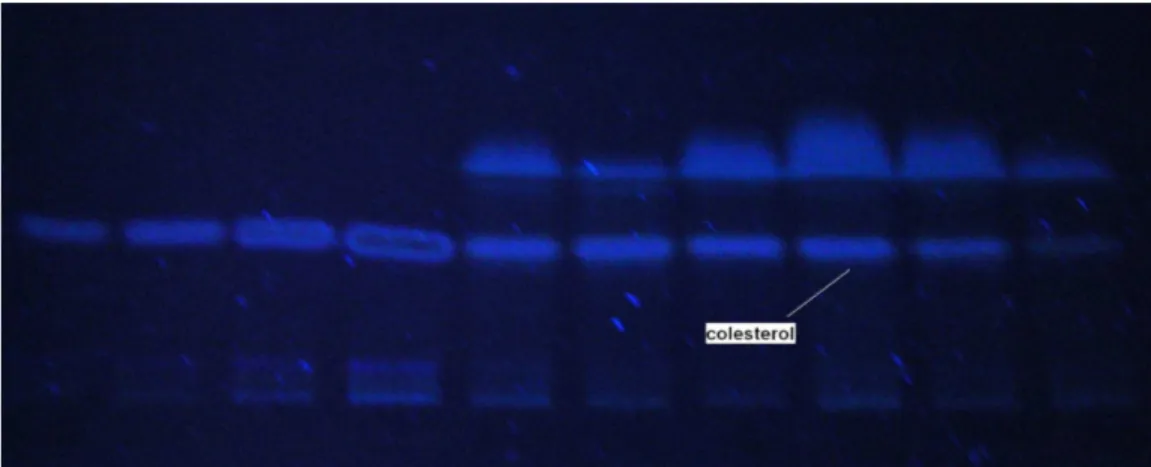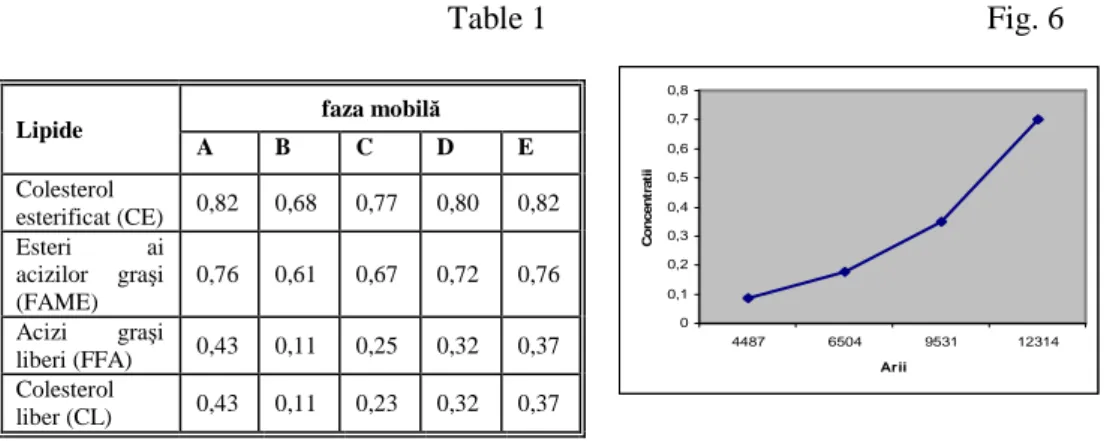Lucrări ştiinŃifice Zootehnie şi Biotehnologii, vol. 41 (2) (2008), Timişoara
STUDY ON THE SEPARATION THROUGH THIN LAYER
CHROMATOGRAPHY OF THE CHOLESTEROL IN THE
BUFFALO MILK ORIGINATING IN THE MESENDORF
FARM
STUDIU PRIVIND SEPARAREA PRIN CROMATOGRAFIE ÎN
STRAT SUB
ł
IRE A COLESTEROLULUI DIN LAPTELE DE
BIVOLI
łĂ
PROVENIT DE LA FERMA MESENDORF
PECE AURELIA*, COROIAN C.*, GHIRILĂ BIANCA*, MUREŞAN G.*
*University Agricultural Science and Veterinary Medicine, Faculty of Animal Husbandry and Biotehnology, 3 – 5 Mănăştur Street, Cluj-Napoca, Romania
Within the present study, we conducted a thin layer chromatographic separation of neuter fats in buffalo milk, following sodium metoxyde saponification and the exposition to λ=366 nm. The extraction of free and esterized milk cholesterol was conducted according to the Folch et al. (1957) method. The free and esterized cholesterol, as well as triglycerids appear as brown spots (iodine complexes with the double connections between the compounds under anlysis). Qualitative identification was conducted through the comparison of Rfs for free and esterized cholesterol, in the samples analyzed with existing standards. The semi-quantitative anlysis was conducted through a visual comparison of the intensity encountered in free cholesterol spots within samples under anlysis and the standard of different concentrations applied on the same board. Buffalo milk samples originated in the Mesendorf Farm, considered and certified as an ecologic farm.
Key words: cholesterol, milk, buffalo
Introduction
Materials and Methods
The extraction of free and esterized milk cholesterol was conducted according to the Folch et al. (1957) method with minor alterations regarding solvent or sample volumes. In this respect, 2.5 ml of milk were extracted using 48 ml chloroform/methanol/water (2:1:1, v/v/v) through intermittent stirring for 30 minutes in a separation funnel. The superior layer (methanol and water) was separated through creasing, while the middle and inferior layers (proteins and chloroform containing free and esterized cholesterol) was vacuum filtered on a Büchner funnel. The chloroform layer was filtered again on anhydrous sodium sulphate, while Na2SO4 is washed three times with 5 ml chloroform each. The fatty
extracts were vacuum evaporated using a rotavapor on 50 ºC, while the residue was recovered with 1 ml chloroform in a 2 ml vial with a teflon lid and kept at 18º C until the analysis.
Fig 1. Extraction and filtering Fig 2. Phase separation
Fig 3.Washing with
water and chloroform Fig 4. Drying on sodium hydroxid
1 ml of methanolic solution of sodium metoxide (0.5M). 1 ml methanol and 1 ml toluen and it is heated to 70 ºC for an hour.
After cooling, 1 ml of distilled water is added and the cholesterol is extracted with 2 x 8 ml ethylic ether in a separation funnel. Ether extracts of cholesterol are filtered through anhydrous sodium sulphate and evaporate dry.
The residue is recovered with 1 ml chloroform in a 2 ml vial. The volume applied (10 µl) was the same for all samples and standards under analysis. A chromatographic Camag camera was sued for developing, covered with a glass lid to avoid the evaporation of more volatile solvents and margn effects.
Results and Discussions
Lipid visualising was conducted through iodine vapor exposition in a chromatographic camera covered with a glass lid. Free cholesterol spots in analyzed samples can be observed after 10 minutes, but they remain visible even 3 hours after iodine vapor exposition.
Fig. 5 The separation through thin layer chromatography of neuter lipids in buffalo milk, after sodium metoxide saponification and the exposition to λ=366 nm
As iodine visualising is not satisfactory, another reactive was employed for visualising and densiometry. As such, spots were visualised with a mixture of copper sulphate/ phosphoric acid (3g copper sulphate in 10 ml phosphoric acid 10%v/v) and heated to 110 ºC for 20 mintes. Spot scanning was conducted with a photodesiometer Camag TLC Scanner 3 at λ = 366 nm for an hour.
0 0,1 0,2 0,3 0,4 0,5 0,6 0,7 0,8
4487 6504 9531 12314 Arii C o n c e n tr a ti i
Table 1 Fig. 6
Table 1 presents the Rfs for a mixture of neuter fat standards using as a mobile phase petroleum ether- ethylic ether- acetic acid.
The solvent ratio (in volumes) in mobile phases: A: 60+ 20 + 12; B: 80 + 20 + 2; C: 80 + 20 + 3; D: 80 + 20 + 6; E: 80 + 20 + 8
As observed in table 1, the mixture of neuter fat standards was appropriately separated after developing with five mobile phases (A-E) employed, with the exception of cholesterol from free fatty acids. Consequently, we opted for mobile phase C, which ensures a satisfactory separation of the two spots (Rf FFA= 0.25 and Rf CL= 0.23).
Fig. 7 Calibration curve for free cholesterol (on the abscissa, cholesterol concentration in mg/ml and on the ordinate the peak surface in u.a)
Conclusions
• As observed from the results presented above, another advantage in the employment of this system resides in the separation of neuter fats in narrow strips;
•
Lipide faza mobilă
A B C D E
Colesterol
esterificat (CE) 0,82 0,68 0,77 0,80 0,82 Esteri ai
acizilor graşi (FAME)
0,76 0,61 0,67 0,72 0,76
Acizi graşi
liberi (FFA) 0,43 0,11 0,25 0,32 0,37 Colesterol
metoxide which is not sufficient for free fatty acids;
• The determination of cholesterol in buffalo milk through thin layer chromatography coupled with a densitometry is considered as a premiere at a national level, with a high degree of sensitivity and accuracy, while the results obtained can be comparable to researches and values of specialty literature.
Bibliography
1. Aurora Popescu, Elena Cristea, Marcela Zamfirescu, (1980) -
Biochimie Medicală. Ed. Medicală, Bucureşti, p.324.
2. Dylewski D.P., Dapper C.H., Valivullah H.M., Deeney J.T., Keenan T. W., (1995) - Morphological and biochemical caracterization of possible
intracelular precursors of milk lipid globules. Eur. J. Cell Biol. 35:99.
3. Lee D.K., Aha J., Kwak H.S., (1999) - Cholesterol removal from
homogeniyed milk with β – cyclodextrin. J.Dairy Sci. 82: 2327 -2330.
4. Petter N., Campbell, Anthony D., Smith, (2004) - Biochimie ilustrată. Ed. academiei române. Bucureşti, p.152-172
5. Pintea Adela, (2005) - Biochimie structurală. Biomolecule plastice, Editura Academic Pres, Cluj-Napoca).
6. Sieber R., (1994) - Cholesterol removal from animal food – can it be

